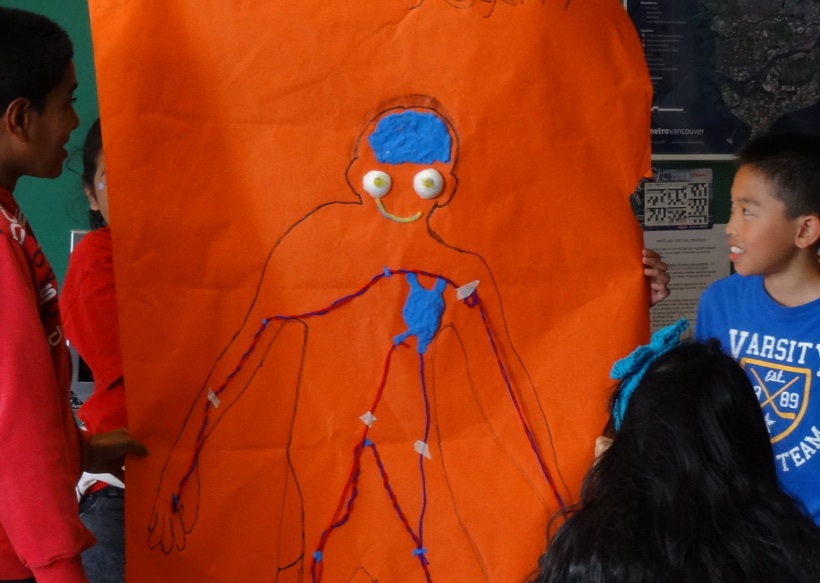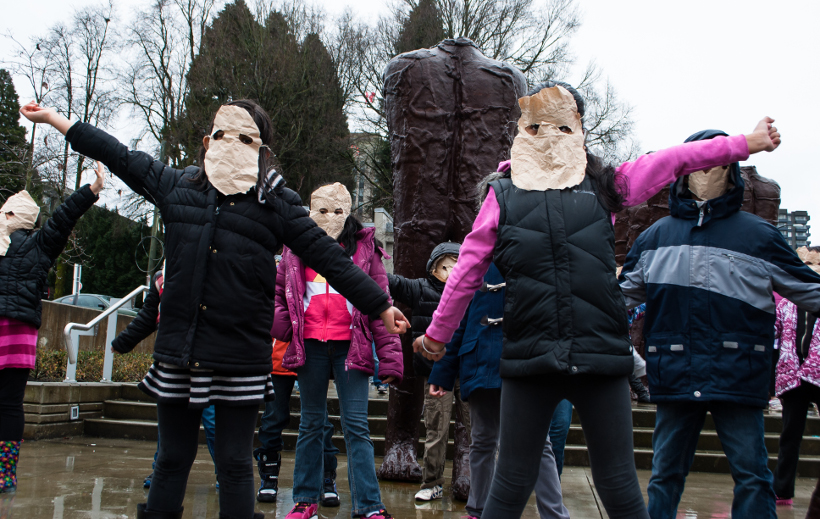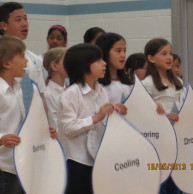How Body Systems Work Together
Science - Grade 5
This unit of inquiry is not a recipe book but rather a launchpad to inspire new BIG IDEAS. We encourage you to use and/or modify one, or several of the BIG IDEAS below. Adapt it to the grade/ ability level of your students.
Enduring Understanding
Systems interact with one another in order to communicate and function.
Guiding Questions
How do body systems work together to perform vital functions? How does the global environment affect our body systems?
Mind Opening
Choose or devise practices to encourage students to be open to new experiences and ways of thinking in your classroom. For example, the MindUP in-school program.
Discovery and Inspiration:
Launch the Project
• Introduce the Theme: Present the Enduring Understanding and Guiding Questions using vocabulary that is appropriate for your grade level.
• About Vancouver Biennale: Play a short video.
• Create Project Space: Brainstorm ideas to make the project theme visual and visible using bulletin boards, and/or a project corner to share relevant materials and inquiry questions and processes.
Reference Resources:
• Introduction to Sculpture and Public Art Unit Plan for information on how art has evolved over time and the unique experience sculptures and/or public art brings
• Vancouver Biennale 2014-2016 Exhibition Theme: Open Borders / Crossroads Vancouver
• Biennale Legacy Artwork: Walking Figures (Magdalena Abakanowicz, Poland)
• About Artist and Artwork (PDF)
Learning to Learn:
Art Inquiry
Make a visit to Walking Figures and encourage students to freely explore and interact with the art pieces individually and in groups. This Art Inquiry process enables the students to practice observing, describing, interpreting, and sharing visual information and personal experiences. Use the Art Inquiry Worksheet (PDF) to guide and capture their ideas and impressions. Customize or create your own Art Inquiry Worksheet as appropriate for your project and class needs.
Shared Insights
• Sharing Art Inquiry Experience: Ask students to share the Art Inquiry Worksheet responses in class.
• Artist Themes – Research: In small groups students rotate between information stations detailing the artist’s life and work. Station topics include: (1) education and training; (2) lifetime of artwork; (2) materials and processes; (3) beliefs and values. At each station, students answer questions and complete a task. For example, at the station “life’s work” students might plot the artist’s various installations on a map of the world.
• Artist Themes – Interactions: Facilitate responses to the grouping and interaction of the Walking Figures. Are there meaningful interactions between the figures? What kinds of groupings are the figures placed in? In our bodies, what types of interactions take place everyday?
• Plasticine Activity: Facilitate an activity with plasticine, clay, or play-do for students to create their own sculptures inspired by the art piece.
Some questions for follow up may include:
- How does the artist use a system to create the Walking Figures?
- Where are these Walking Figures going?
- Are these figures connected to or in communication with each other?
- What kind of experiences do you think these figures might have?
- Can you connect to the experience of these Walking Figures? Describe.
Inquiry Challenges
• Dancing Heartbeat What body systems work together to perform vital functions?
Students take part in a dance-related exercise. Teach students how to monitor a heart rate. Heart rates are checked as the pace of the dance changes. Guide the students to take note of other body reactions such as body temperature, sweating and breathing.
Debrief so that students can share their personal feelings about the experience, and possibly raise their own inquiries. Possible questions include:
- How did your body feel when you heard the music?
- Did your heart rate change? Why or why not? What other changes did you notice as the music changed?
- How did the environment affect your experience?
• Body Systems: Students represent their research on a human body system. Students can trace their bodies and use materials of their choice to represent selected systems and components. They can present their research to their peers, acting as experts of their chosen body system. While researching, challenge students to think about how systems are connected and work together to perform specific functions; e.g. how does oxygen enter our body and what carries it around?
• Brain Challenges: Create a station approach where students work together on brain activity and function challenges. For example, Brain Challenges → Puzzle stations to challenge thinking about the brain: Stroop Effect, Mobius Strip, Brain hemisphere, Create a jigsaw puzzle of the brain, etc.
• The Inhibitor: Complete various obstacle courses while parts of the body are inhibited. For example, a three legged race. Discuss how their bodies adapted to the change. Discuss how various muscle groups are interconnected with one another and how the rest of their bodies adapt accordingly. Possible videos to include: video of brains reacting to different stimulations; video or case study of people who have had brain injuries.
Student Creation
Exhibit student artistic creations from the Human Body Challenge and the Art Education – Visual Arts.
Taking Actions
Students explore and reflect on the transportation/traffic systems in their community. They can research the impact of a system on stakeholder well-being (e.g. impacts on health, impact on the environment). Students can suggest solutions to identified issues and take this plan to the appropriate authority after seeking support from school administration and/or PAC.
Reflection
• Teacher and students can reflect on their entire learning process by revisiting the Enduring Understanding and relevant Guiding Questions.
• How did the unit of study open inquiry, create cross–curricular learning opportunities and/or apply learning to real life situations? Has this unit of inquiry changed your opinions, values and world view? In what ways, if any, has it helped you grow as a learner?
Ideas for Cross-Curricular Access
• Arts Education – Visual Arts: Have students create a multi-media representation of a body system using found objects. Have students share how they associate their choice of materials (texture, colour, shape) with the specific body system.
• Arts Education – Dance: Have students dance in response to music evoking different emotions. Debrief with students about how their bodies felt and the reasons why they reacted the way they did.
• Health and Career Education – Healthy Living: Have students take note of the foods they eat and how they affect how their bodies feel or function, such as energy level. Find out more about various food groups in terms of their properties and nutrients, and how they are processed through our body systems: digestive, circulatory to generate energy or causing fatigue. Compare their eating preferences as to Canadian food pyramid with what our bodies need to function. Further challenges include discussion on how the global food chain affects what food is available to us.
• Mathematics – Shape: Select organs and identify what standard shape best match each organ. Find out respective dimensions and calculate the approximate size. Research whether the organ size changes with age, gender and ethnicity.
• Social Studies – Economy and Technology: Research on the transportation of natural resources and the most common goods transported from different regions of Canada during the study time period. Analyze what factors influence the development of a transportation system. How and where do these transportation systems take goods? Do some regions of Canada import or export more goods? Why and with what consequences? Find the similarities between transportation systems to the human body system. Do transportation systems have an effect on our body? (e.g. air pollution, habitats, and food imports from other countries).
Credits
Written by: Natasha Chia En Chiang, Erin Coward and Ashleigh Wong, 2013 UBC Elementary School Teacher Candidates
©2013 Vancouver Biennale


